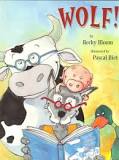Jenni Connor brings a wealth of knowledge and experience to argue a case for the value of reading aloud to children. This week's post is a fitting follow up on sharing favourites, to explore the joys of oral reading to build a love of literature and language.
In this electronic age, people might wonder if there is
still a place for print books in our lives, and especially in the lives of
children.
The jury is not out on that one – research firmly indicates
that the act of reading aloud with "a child is the single most important thing
adults can do to promote the emergent literacy skills of young children’ (Shogi, Willersdorf, Braganza & McDonald, 2013, p. 22).
With babies, we read soothing stories such as AlisonLester’s Kissed by the Moon (Viking,
2013). It is a lyrical lullaby, with a repeated refrain – May you, my baby, sleep softly at night…May you, my baby, make
sprinkles of sand…and may you, my baby, be kissed by the moon. Lester’s
soft wash illustrations are charmingly apt, capturing the close bond between
adult and child and the infant’s wonder at the natural world.
Toddlers are ready for a picture book with a story and
familiar characters and themes, such as the Snail
and Turtle series by Stephen Michael King (Scholastic Australia, 2014).
Colourful, bold, uncluttered illustrations give two- and three-year olds plenty
to talk about as these very different friends go about their pleasant lives – Snail likes early mornings after the rain.
Turtle likes any day, as long as it’s wet’.
Pre-schoolers have enough experience to relate to characters and places. Anna Walker’s Peggy (Scholastic Australia, 2012) seems to grab their attention as Peggy the chook is blown by a blustery wind from her ‘small house in a quiet street’ into the big city. Peggy ‘saw things she had never seen before’, but she was very grateful when the pigeons showed her the way back to her yard. Feeling lost and small, excited but nervous about being away from home is an emotional landscape familiar to young children.
Reading quality literature regularly with children exposes
them to a rich, resonant vocabulary they will not encounter in everyday talk, or
through other media. Children learn to ‘savour the gift of words’ and build a
bank of powerful words and phrases. Isabella’s
Garden, by Glenda Millard and Rebecca Cool (Walker Books, 2009) is a
stunningly beautiful picture book, with vibrant illustrations, wonderful rhythm,
alliteration and glorious descriptive language –
that ruffles the buds,
all velvety-skinned
that swelled the
shoots that sought the sun
that kissed the clouds
that cried the rain
that soaked the seeds
that slept in the soil
all dark and deep, in
Isabella’s garden.
As Patsy Jones made clear in her blog post (2017, September 23) last week about
favourite picture books - "The importance of picture books to
me as a parent and a grandparent is the close relationship reading to your
child will develop in so many ways."
With books like these, shared lovingly by caring adults,
every child can enter the garden of literacy and gain power over their world
and live in harmony with it.
Jenni Connor
Writing and Educational Consultant


























